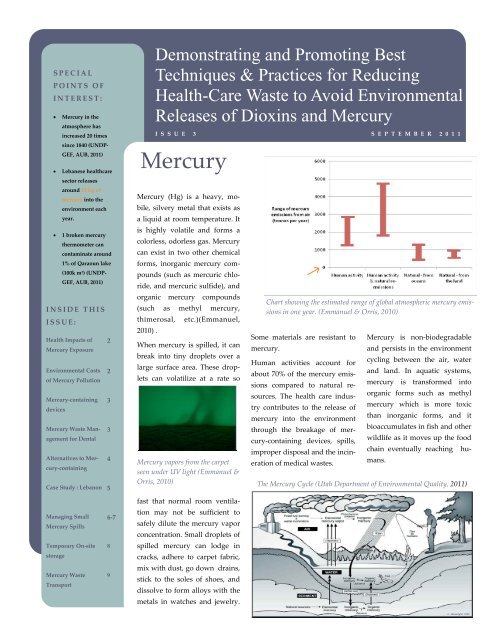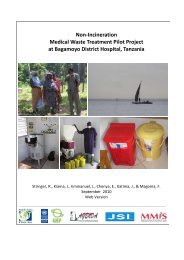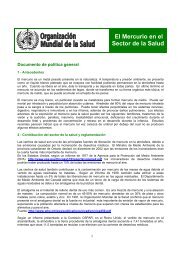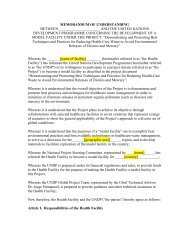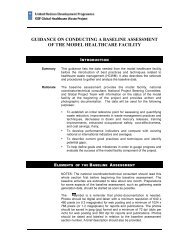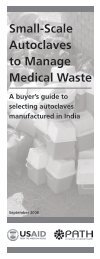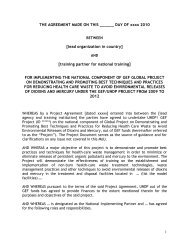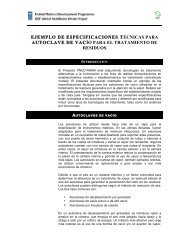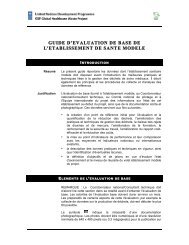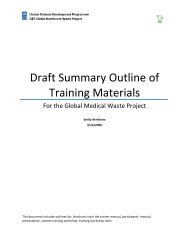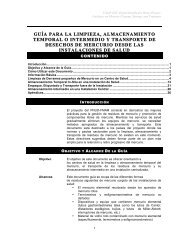UNDP/GEF Global Healthcare Waste Project Newsletter- Issue 3
UNDP/GEF Global Healthcare Waste Project Newsletter- Issue 3
UNDP/GEF Global Healthcare Waste Project Newsletter- Issue 3
You also want an ePaper? Increase the reach of your titles
YUMPU automatically turns print PDFs into web optimized ePapers that Google loves.
SPECIAL<br />
POINTS OF<br />
INTEREST:<br />
• Mercury in the<br />
atmosphere has<br />
increased 20 times<br />
since 1840 (<strong>UNDP</strong>‐<br />
<strong>GEF</strong>, AUB, 2011)<br />
• Lebanese healthcare<br />
sector releases<br />
around 31 kg of<br />
mercury into the<br />
environment each<br />
year.<br />
• 1 broken mercury<br />
thermometer can<br />
contaminate around<br />
1% of Qaraoun lake<br />
(100k m 2 ) (<strong>UNDP</strong>‐<br />
<strong>GEF</strong>, AUB, 2011)<br />
INSIDE THIS<br />
ISSUE:<br />
Health Impacts of 2<br />
Mercury Exposure<br />
Environmental Costs 2<br />
of Mercury Pollution<br />
Mercury‐containing 3<br />
devices<br />
Mercury <strong>Waste</strong> Management<br />
for Dental<br />
3<br />
Alternatives to Mercury‐containing<br />
4<br />
Case Study : Lebanon 5<br />
Demonstrating and Promoting Best<br />
Techniques & Practices for Reducing<br />
Health-Care <strong>Waste</strong> to Avoid Environmental<br />
Releases of Dioxins and Mercury<br />
I S S U E 3<br />
Mercury<br />
Mercury (Hg) is a heavy, mobile,<br />
silvery metal that exists as<br />
a liquid at room temperature. It<br />
is highly volatile and forms a<br />
colorless, odorless gas. Mercury<br />
can exist in two other chemical<br />
forms, inorganic mercury compounds<br />
(such as mercuric chloride,<br />
and mercuric sulfide), and<br />
organic mercury compounds<br />
(such as methyl mercury,<br />
thimerosal, etc.)(Emmanuel,<br />
2010) .<br />
When mercury is spilled, it can<br />
break into tiny droplets over a<br />
large surface area. These droplets<br />
can volatilize at a rate so<br />
Mercury vapors from the carpet<br />
seen under UV light (Emmanuel &<br />
Orris, 2010)<br />
Some materials are resistant to<br />
mercury.<br />
Human activities account for<br />
about 70% of the mercury emissions<br />
compared to natural resources.<br />
The health care industry<br />
contributes to the release of<br />
mercury into the environment<br />
through the breakage of mercury‐containing<br />
devices, spills,<br />
improper disposal and the incineration<br />
of medical wastes.<br />
S E P T E M B E R 2 0 1 1<br />
Chart showing the estimated range of global atmospheric mercury emissions<br />
in one year. (Emmanuel & Orris, 2010)<br />
Mercury is non‐biodegradable<br />
and persists in the environment<br />
cycling between the air, water<br />
and land. In aquatic systems,<br />
mercury is transformed into<br />
organic forms such as methyl<br />
mercury which is more toxic<br />
than inorganic forms, and it<br />
bioaccumulates in fish and other<br />
wildlife as it moves up the food<br />
chain eventually reaching humans.<br />
The Mercury Cycle (Utah Department of Environmental Quality, 2011)<br />
Managing Small<br />
Mercury Spills<br />
Temporary On‐site<br />
storage<br />
Mercury <strong>Waste</strong><br />
Transport<br />
6‐7<br />
8<br />
9<br />
fast that normal room ventilation<br />
may not be sufficient to<br />
safely dilute the mercury vapor<br />
concentration. Small droplets of<br />
spilled mercury can lodge in<br />
cracks, adhere to carpet fabric,<br />
mix with dust, go down drains,<br />
stick to the soles of shoes, and<br />
dissolve to form alloys with the<br />
metals in watches and jewelry.
PAGE 2<br />
“Even a small<br />
quantity of<br />
mercury can lead<br />
to mercury<br />
Health Impacts<br />
of Mercury<br />
Exposure<br />
All forms of mercury are toxic<br />
at varying degrees, but the<br />
health effects depend on:<br />
1. The form of mercury<br />
(elemental, organic or inorganic);<br />
2. The type of exposure<br />
(acute, or chronic);<br />
3. The route of exposure<br />
(inhalation, ingestion or<br />
dermal);<br />
4. The amount of mercury.<br />
Inhalation of mercury vapor<br />
leads to damage in the central<br />
and peripheral nervous systems,<br />
lungs, kidneys, skin and<br />
eyes. It also affects the immune<br />
system and is<br />
mutagenic.<br />
A study investigating the<br />
Health impacts of methyl mercury exposure on humans (Emmanuel &<br />
Orris, 2010)<br />
impact of prenatal methyl<br />
mercury exposure on cognitive<br />
development showed<br />
that exposure sufficient to<br />
increase the mercury concentration<br />
in maternal hair at<br />
child birth by 1 micrograms<br />
per gram could decrease the<br />
child’s IQ by about 0.7 points<br />
(Emmanuel & Orris, 2010).<br />
Dentists and dental assistants<br />
are exposed to metallic<br />
mercury vapor from dental<br />
amalgam; thus they are<br />
Mercury pollution has a variety<br />
of costs, so‐called externalities,<br />
not included in the<br />
prices the producers and<br />
consumers pay for products<br />
and services:<br />
ter and air. (Hylander &<br />
Goodsite, 2006)<br />
One study investigated the<br />
environmental costs of mercury<br />
pollution in the Arctic.<br />
It showed that with an average<br />
• Reduced recreational<br />
annual marine produc‐<br />
value of polluted areas; tion value of 128.7 million<br />
US$, Greenland alone runs<br />
(Brinkerhoff, 2010)<br />
• Culture losses;<br />
an estimated 31.5 million<br />
• Reduced biodiversity, fish<br />
and other feed and food<br />
resources not suitable for<br />
consumption or become<br />
extinct;<br />
US$ in costs of Hg polluted<br />
marine products (up 24.5%<br />
of the total production value<br />
is lost due to mercury pollution).<br />
toxicity of children born is<br />
estimated to 59.1 million US$<br />
each year (considering that<br />
loss of intelligence causes<br />
diminished economic productivity<br />
over the entire lifetime)<br />
(Hylander & Goodsite,<br />
• Health effects from Hg The study also showed that<br />
entering the body via contaminated<br />
food, soil, wa‐<br />
IQ due to methyl<br />
in Greenland, the cost of lost<br />
2006).<br />
mercury<br />
highly susceptible to mercury<br />
poisoning due to the long‐term<br />
accumulation of low levels of<br />
mercury. Data retrieved from<br />
dental clinics in Beirut, Lebanon<br />
showed that among 99 dentists<br />
tested, 25.25% had a hair mercury<br />
level above the safe baseline<br />
of 5μg/g (Harakeh, Sabra,<br />
Kassak, & Doughan, 2002) .<br />
poisoning,<br />
particularly in<br />
children” ‐ HCWH<br />
Environmental Costs of Mercury
ISSUE 3<br />
PAGE 3<br />
Mercury‐Containing Devices in <strong>Healthcare</strong> Facilities<br />
Mercury can be found in a<br />
number of products and<br />
devices used in healthcare<br />
facilities, some of which are<br />
listed below (Health Care<br />
Without Harm, 2010).<br />
• Thermometers;<br />
• Sphygmomanometers;<br />
• Dental Amalgam;<br />
• Batteries;<br />
• Ultraviolet thermostats<br />
• Thermostat probes in<br />
electrical equipment;<br />
• Pressure gauges;<br />
• Chemical and pharmaceutical<br />
products that<br />
may contain traces of<br />
mercury as a contaminant<br />
or additive;<br />
• Cleaners and degreasers<br />
with caustic soda or chlorine<br />
contaminated with<br />
mercury.<br />
Refer to the table on the next<br />
page for examples of mercury<br />
‐containing chemicals.<br />
Dental Amalgam<br />
Capsule (FDA,<br />
2009)<br />
Mercury <strong>Waste</strong> Management for Dental Facilities<br />
Mercury is about 50% of dental amalgam<br />
by weight. In many dental facilities,<br />
a powder mix of metals<br />
(generally silver, tin, copper, and zinc)<br />
are weighed and mixed with mercury<br />
to form the amalgam. Depending on<br />
the size of the amalgam, the amount<br />
of mercury could range from 327 to<br />
982 milligrams per amalgam.<br />
Dental facilities are a significant<br />
source of mercury in the wastewater.<br />
The amount of mercury discharged by<br />
a single dental facility depends,<br />
among others, on whether or not mercury<br />
retention devices are used. When<br />
no filters are used, one study estimated<br />
an average of 2 grams of mercury<br />
per dentist per day may be discharged<br />
into the wastewater.<br />
The first recommendation in mercury<br />
waste management for dental facilities<br />
is to use amalgam substitutes in cases<br />
where they are appropriate and feasible.<br />
Some commercially available alternatives<br />
to mercury are: cold silver,<br />
gallium, ceramic, porcelain, polymers,<br />
composites, and glass ionomers. However,<br />
these alternatives are not yet<br />
widely known nor accepted in many<br />
countries.<br />
General recommendations regarding<br />
mercury retention devices for dental<br />
facilities:<br />
• Have multiple levels of amalgam<br />
retention devices installed as<br />
much as possible, since chair‐side<br />
traps and vacuum pump filters<br />
only remove between 40 to 80% of<br />
amalgam from the wastewater.<br />
Multiple levels refer to the installation<br />
of dental amalgam separators<br />
and vacuum filters along<br />
with chair‐side traps.<br />
Figure 1 gives examples of different<br />
configurations of multiple amalgam<br />
retention devices depending on<br />
whether a dry or wet vacuum system<br />
is used.<br />
• After installing amalgam retention<br />
devices, replace old plumbing<br />
sink traps and other low<br />
points in the plumbing where<br />
amalgam may have settled. Collect,<br />
store, and label the amalgam<br />
waste (Emmanuel, 2011).<br />
Figure 1: Examples of<br />
Multiple Levels of<br />
Amalgam Retention<br />
Devices (Emmanuel,<br />
2011)
PAGE 4<br />
Alternatives to Mercury‐Containing Devices in healthcare<br />
Facilities<br />
Mercury‐containing Device<br />
Thermometers<br />
Alternatives<br />
Mainly digital or electronic thermometer<br />
Sphygmomanometer<br />
Amalgam dental fillings<br />
Aneroid or oscillometric devices<br />
Glass ionomer/composite/resin fillings<br />
Mercury‐free sphygmomanometers:<br />
aneroid (left),<br />
digital oscillometric (right)<br />
(<strong>UNDP</strong>‐<strong>GEF</strong>, 2010)<br />
Mercury‐free thermometers:<br />
electronic (left), compact<br />
electronic (right)<br />
(<strong>UNDP</strong>‐<strong>GEF</strong>, 2010)<br />
Thermostats<br />
Fluorescent tubes<br />
Batteries<br />
Manometers<br />
Gastrointestinal tubes<br />
Chemicals<br />
Mercury (II) chloride<br />
Zenker’s solution<br />
Histological fixatives<br />
Staining solutions and preservatives for<br />
such products as buffers and vaccines:<br />
Thimerosal, Immu‐sal, Carbol‐fuchin<br />
stain, Gram iodine stain, phenolic mercuric,<br />
actate, alum, Hematoxylin<br />
“Solution A”<br />
Mercury (II) oxide<br />
Mercury chloride<br />
Mercury (II) chloride<br />
Mercury (II) sulfate<br />
Mercury iodide<br />
Mercury nitrate (for corrosion of copper<br />
alloys) for antifungal use<br />
(mercurochrome)<br />
Electronic<br />
Bulbs with low Hg content<br />
Mercury‐free/ rechargeable batteries<br />
(lithium, zinc, alkaline)<br />
Electronic<br />
Tubes with tungsten weights<br />
Alternatives<br />
Zinc formalin<br />
Freeze drying<br />
Replace with variety of chemical compounds<br />
Copper catalyst<br />
None identified<br />
Magnesium chloride/sulfuric acid or zinc<br />
formalin, freeze drying<br />
Silver nitrate/potassium/ chromium‐ (III)<br />
sulfate<br />
Phenate method<br />
Ammonia/copper sulfate<br />
Neosporin mycin<br />
For more details see:<br />
Emmanuel, J. (2010). Guidance on the Technical Specifications of Non‐Mercury Devices.<br />
<strong>UNDP</strong>‐<strong>GEF</strong>.<br />
Health Care Without Harm. (2010). Guide for Eliminating Mercury from <strong>Healthcare</strong><br />
Establishments.
VOLUME 1, ISSUE 1<br />
PAGE 5<br />
Case Study: Comparative Evaluation of Non‐Mercury Thermometers<br />
in Nabatieh Governmental Hospital and <strong>Healthcare</strong> Staff Preferences<br />
A study evaluating available, affordable<br />
and accurate alternatives to mercury<br />
containing thermometers was<br />
conducted using the Nabatieh Governmental<br />
Hospital (NGH) as the<br />
pilot facility for the phasing out plan<br />
(of mercury‐containing devices). The<br />
study examined the differences between<br />
two non‐mercury alternative<br />
thermometers and the nursing staff<br />
preferences based on the following<br />
primary attributes: costs, maintenance,<br />
lifespan, accuracy and ease of<br />
use.<br />
Economic comparison of the different<br />
alternatives showed the cost effectiveness<br />
of the electronic thermometer,<br />
especially on the long run. Based<br />
on this comparative evaluation of<br />
thermometers, compact electronic<br />
and electronic thermometers appear<br />
to be the most cost effective types.<br />
Nursing leadership favored the electronic<br />
and the compact electronic<br />
thermometers. Clinical evaluation of<br />
the two alternative thermometers<br />
showed that their readings differed<br />
significantly, both statistically and<br />
clinically. Since the electronic thermometer<br />
is the more established alternative<br />
as per the literature, the<br />
compact electronic thermometer was<br />
not found to be an accurate replacement<br />
for it.<br />
Clinical evaluation of the ease of use<br />
reflected a significant difference in<br />
the measurement time, again favoring<br />
the electronic thermometer. The<br />
nursing staff expressed preference for<br />
the electronic thermometer regarding<br />
its user friendliness, patient acceptability,<br />
and infection control, while<br />
compact electronic thermometer was<br />
favored for durability.<br />
In conclusion, the study provided<br />
evidence for the superiority of the<br />
electronic thermometer, of the brand<br />
available in the Lebanese market, as<br />
the best alternative for the mercury<br />
thermometer.<br />
For the details of the study, refer to:<br />
Nafaa, A. I. (2011). Comparative<br />
Evaluation of Non‐Mercury Thermometers<br />
in Nabatieh Governmental Hospital<br />
and <strong>Healthcare</strong> Staff Preferences. <strong>UNDP</strong><br />
‐<strong>GEF</strong> <strong>Global</strong> <strong>Healthcare</strong> <strong>Waste</strong> <strong>Project</strong>.<br />
Comparative Costing of Thermometers in USD ($) (Nafaa, 2011)<br />
Type of Thermometers<br />
Electronic<br />
Compact electronic<br />
Infrared tympanic<br />
Infrared temporal<br />
Mercury<br />
Total investment<br />
cost<br />
10,029 2,719 3,292 6,580 23,092<br />
Total annual running<br />
cost<br />
8,807 15,603 30,543 33,556 31,213<br />
Total cost at year<br />
one<br />
18,836 18,322 33,835 40,136 54,305
PAGE 6<br />
Managing Small Mercury Spills<br />
(Emmanuel & Orris, 2010)<br />
NEVER:<br />
⊗ use a vacuum cleaner to<br />
clean up mercury<br />
⊗ use a broom to clean up<br />
mercury<br />
⊗ pour mercury down the<br />
drain<br />
⊗ wash mercurycontaminated<br />
items in a<br />
washing machine<br />
⊗ continue wearing shoes<br />
and clothing that might<br />
have been contaminated<br />
in the mercury spill<br />
⊗ burn anything that has<br />
been contaminated with<br />
mercury<br />
Spill Kit<br />
Although mercury spill kits are commercially<br />
available, a spill kit can be<br />
made by putting together the following<br />
items and storing them in a marked<br />
box or portable container.<br />
◊ Step‐by‐step instructions with waste<br />
collection and disposal protocols;<br />
◊ Personal protective equipment<br />
(PPE):<br />
•Rubber or nitrile gloves;<br />
• Safety goggles or protective<br />
eyewear;<br />
•Respiratory protection (face<br />
mask);<br />
•Coveralls, apron, and other protective<br />
clothing (e.g. disposable<br />
shoe covers);<br />
◊ Containers:<br />
•Air‐tight, sealable plastic bags<br />
(small and large sizes, thickness:<br />
2 to 6 mils, or 50 to 150 microns);<br />
•Air‐tight, rigid plastic container<br />
with vapor suppression agent<br />
for collecting elemental mercury<br />
;<br />
• Air‐tight, puncture‐resistant,<br />
rigid plastic or steel container<br />
with a wide opening for collecting<br />
mercury‐contaminated broken<br />
glass;<br />
• Plastic tray;<br />
• Regular plastic waste bags<br />
(thickness: 2 to 6 mils, or 50 to<br />
150 microns);<br />
◊ Tools for removing mercury<br />
• Flashlight;<br />
• Cardboard strips or thin pieces<br />
of plastic;<br />
• Small plastic scoop or plastic<br />
dust pan ;<br />
• Tweezers;<br />
• Eyedropper or syringe (without<br />
the needle);<br />
• Duct tape or sticky tape;<br />
• Vapor suppression agents:<br />
⇒Sulfur powder (available<br />
from pharmacies), zinc or<br />
copper flakes (available from<br />
hardware stores);<br />
⇒Brush to remove powder or<br />
flakes;<br />
• Utility knife blade;<br />
◊ Materials for decontamination:<br />
• Vinegar, hydrogen peroxide,<br />
and cotton swabs for final cleaning<br />
when using sulfur powder;<br />
• Decontaminant solution or commercial<br />
decontaminant;<br />
• Piece of soap and paper towels;<br />
◊ “Danger: Mercury <strong>Waste</strong>” labels to<br />
put on waste containers.<br />
All spill kits should have a sheet attached<br />
indicating when they were used<br />
and verifying that the expended supplies<br />
have been replaced. The sheet<br />
should be signed and dated by the responsible<br />
staff (Emmanuel, 2010).<br />
Seek immediate<br />
medical attention<br />
if sickness occurs<br />
(Health Care<br />
Without<br />
Harm, 2010)
This detailed mercury spill cleanup procedure is intended as a guide to help develop facility‐specific procedures. Each<br />
healthcare facility should develop its own procedures according to what is practical and available while maximizing<br />
protection for their patients and health workers. (Emmanuel, Guidance on Cleanup... , 2010)<br />
PAGE 7<br />
Mercury Spill Cleanup Procedure<br />
Put on personal protective<br />
equipment (rubber or nitrile<br />
gloves, apron, goggles<br />
and facemask)<br />
Block the path of the mercury<br />
beads with rags or<br />
impervious material.<br />
Evacuate the spill area and turn off ventilation<br />
system. Ensure good ventilation by<br />
opening windows and doors to outside<br />
areas free of people.<br />
Identify the surface contaminated:<br />
• hard surfaces can be easily cleaned.<br />
• carpet, curtains, upholstery and the<br />
likes cannot; these should be cut off<br />
and thrown away.<br />
Wash skin that came in contact<br />
with mercury using<br />
alkaline soap.<br />
Remove broken glass pieces using<br />
tweezers. Place them in punctureresistant<br />
container over the tray.<br />
Locate all the<br />
mercury beads.<br />
Using cardboard strips slide the mercury<br />
beads onto the plastic dustpan or<br />
scoop, and away from any carpet or<br />
porous surface. Use an eyedropper or<br />
syringe for small beads.<br />
Carefully place the mercury<br />
beads into the plastic container<br />
partially filled with water or vapor<br />
suppression agent. Do this<br />
over the tray to catch any spillage.<br />
Shine flashlight at<br />
low angles on floor<br />
and locate shiny<br />
mercury beads.<br />
Use sticky tape to<br />
pick up tiny droplets<br />
of mercury. Place in a<br />
sealable plastic bag.<br />
Place ALL contaminated<br />
materials into a<br />
leak‐proof sealable plastic<br />
bag.<br />
Ensure that all mercurycontaminated<br />
waste is<br />
now secured in labeled<br />
Document the incident<br />
bags and will be disposed<br />
according to proce‐<br />
Clean thoroughly with<br />
properly. The<br />
dures of the health<br />
decontaminant solution<br />
mercury waste can be<br />
facility. The report can<br />
items that can be<br />
stored temporarily onsite.<br />
safety in the facility.<br />
be used to improve<br />
For reused more (tweezers, details see:<br />
Guidance tray...etc.) on the Cleanup, Temporary or Intermediate Storage, and Transport of Mercury <strong>Waste</strong><br />
from <strong>Healthcare</strong> Facilities - <strong>Issue</strong>d by the <strong>UNDP</strong>-<strong>GEF</strong> <strong>Global</strong> Health Care <strong>Waste</strong> <strong>Project</strong>.
PAGE 8<br />
Elements for Temporary On‐site Storage<br />
STORAGE AREA:<br />
volume of mercury stored).<br />
• Use primary containers for<br />
Siting<br />
• Storage are kept dry and cool<br />
storage of mercury waste:<br />
• Secure restricted area.<br />
( 25ºC and < 40% humidity).<br />
leak‐proof, airtight, non‐<br />
• Readily accessible to author‐<br />
• Spill kit, PPE and wash<br />
brittle, and made of mate‐<br />
ized staff.<br />
station available near (but not<br />
rial that does not amalga‐<br />
• Separate from regular infec‐<br />
in) the storage area.<br />
mate with mercury (for<br />
tious waste storage area.<br />
Signage<br />
sharps and mercury de‐<br />
“Knowing is<br />
not enough; we<br />
must apply.<br />
Willing is not<br />
enough; we<br />
must do.”<br />
—Goethe<br />
Design<br />
• Enclosed area (roof and<br />
walls).<br />
• Locked door.<br />
• Proper size (based on amount<br />
of waste and devices to be<br />
stored).<br />
• Ventilation— exhaust vent<br />
directly to outside, away<br />
from intake vents with ventilation<br />
control.<br />
• Seamless, smooth and impervious<br />
floor (polyurethane<br />
coated, epoxy‐coated cement,<br />
or seamless rubber).<br />
• Bunding or waste containment<br />
tray on the floor below<br />
the waste containers (125%<br />
• Entry and exit doors marked<br />
with warning signs: “Danger:<br />
Hazardous <strong>Waste</strong>” and the<br />
skull‐and‐crossbones symbol.<br />
• Containers labeled<br />
“Hazardous Mercury <strong>Waste</strong>”<br />
with a description of contents<br />
and initial date of storage.<br />
GENERAL STORAGE AP‐<br />
PROACH<br />
(Emmanuel, 2010)<br />
vices, use punctureresistant<br />
containers).<br />
• Add vapor suppression<br />
agent for elemental mercury<br />
and dental amalgam<br />
waste.<br />
• Use secondary containers<br />
as a redundant safety measure.<br />
• Label containers with date<br />
of initial storage, content<br />
type and quantity of waste.<br />
• Place spill‐control trays<br />
under the storage containers<br />
(Emmanuel, 2010).<br />
Labeling on primary storage<br />
container (Abejar‐Arago, 2008)<br />
Sealed and labeled secondary<br />
container ready for storage.<br />
(Abejar‐Arago, 2008)<br />
Mercury waste storage containers<br />
with spill containment trays<br />
placed below (<strong>UNDP</strong>‐<strong>GEF</strong>)<br />
For more details on mercury waste management refer to:<br />
Emmanuel, J. (2010). Guidance on Cleanup, Temporary or Intermediate Storage, and Transport<br />
of Mercury <strong>Waste</strong> from <strong>Healthcare</strong> Facilities. <strong>UNDP</strong>‐<strong>GEF</strong>.
ISSUE 3<br />
PAGE 9<br />
Some Guidelines for Mercury <strong>Waste</strong><br />
Packaging:<br />
• In preparation for transport, mercury<br />
waste should be placed in a<br />
transport container that is closed,<br />
structurally sound, compatible with<br />
the contents, and designed to prevent<br />
release of mercury. If the original<br />
transport case or box in which<br />
devices were shipped is still in<br />
good condition, it can be used for<br />
shipment of unbroken devices.<br />
• The mercury waste should be<br />
packed carefully with packing material<br />
such as plastic bubble wrap<br />
or plastic packing foam to prevent<br />
breakage inside the container.<br />
• The transport container should be<br />
tightly sealed to prevent escape of<br />
mercury if breakage occurs.<br />
Labeling:<br />
• The outside of the container used<br />
for transport should have a clear<br />
label “Hazardous Mercury <strong>Waste</strong>.”<br />
• The label should also include content<br />
(chemical composition or description<br />
of the waste), warnings,<br />
special handling procedures if necessary,<br />
emergency contact numbers,<br />
and the name and contact<br />
information of the generator.<br />
Preparation:<br />
A special permit/license for transporter<br />
is given by the regulatory authority.<br />
Registered vehicle<br />
• Passed inspection<br />
• Closed design, correct size for the<br />
intended load<br />
• Bulkhead between driver cabin<br />
and body<br />
• System to keep load secure during<br />
transport<br />
• Spill kit, first‐aid kit, fire extinguisher<br />
• Placard<br />
Off‐site Transport<br />
• Before transport, the transporter<br />
should inspect all the waste containers<br />
to ensure that they are<br />
packed and labeled properly.<br />
• The waste containers should be<br />
placed in the back of the vehicle<br />
(not in the passenger section).<br />
• All waste containers should be firmly<br />
secured such that the containers do<br />
not tip over, slide, or shift during<br />
accelerations, stops, turns, and driving<br />
over bumps and holes on the<br />
road.<br />
• Containers should not be stacked<br />
more than 1.5 meters high.<br />
• The transport vehicle should be kept<br />
locked whenever there is waste in the<br />
vehicle except during inspection,<br />
loading, and unloading.<br />
• The transporter should transport the<br />
waste as soon as possible using the<br />
safest or most direct route to the storage<br />
facility.<br />
• The transport vehicle should be kept<br />
clean and maintained in good running<br />
condition.<br />
• The registered vehicle should be used<br />
to transport<br />
mercury and<br />
other hazardous<br />
wastes<br />
o n l y<br />
(Emmanuel,<br />
2010).<br />
For more details on mercury waste transport refer to:<br />
Emmanuel, J. (2010). Guidance on Cleanup, Temporary or Intermediate Storage, and Transport of Mercury <strong>Waste</strong> from <strong>Healthcare</strong> Facilities.<br />
<strong>UNDP</strong>‐<strong>GEF</strong>.<br />
General Procedures<br />
• All personnel involved in<br />
collection, storage, transport,<br />
and supervision of mercury<br />
waste should receive special<br />
training on mercury waste<br />
management including spill<br />
cleanup.<br />
• Material Safety Data Sheets<br />
and International Chemical<br />
Safety Cards on mercury<br />
should be discussed with employees.<br />
• The most senior staff involved<br />
in a cleanup is responsible for<br />
ensuring replenishment of the<br />
contents of the spill kits.<br />
• The storage space should be<br />
inspected every month to<br />
check for leaks, corroded or<br />
broken containers, improper<br />
methods of storage, ventilation,<br />
the condition of the PPE<br />
and wash area, spill kit contents,<br />
and updated records.<br />
• Inventory records should be<br />
kept of the types of mercury<br />
waste, descriptions, quantities<br />
in storage, and initial<br />
dates of storage.<br />
• No smoking or eating<br />
should be allowed in and<br />
around the storage space<br />
(Emmanuel, 2010).
<strong>Project</strong> Objectives<br />
Demonstrating Best Techniques<br />
and Practices for Reducing Health<br />
Care <strong>Waste</strong> to Avoid Environmental<br />
Releases of Dioxins and Furans<br />
Ministry of Environment<br />
Lazarieh Bldg., P.O.Box: 11‐2727<br />
Beirut, Lebanon<br />
Phone: +961‐1‐976555 Ext. 419 or 469<br />
Fax: +961‐1‐976530<br />
E‐mail: s.khalil@moe.gov.lb or<br />
d.mawla@moe.gov.lb<br />
“Special acknowledgment to Ms.<br />
Diana Mikati for preparing this issue<br />
during her internship at the project”.<br />
The overall goal of this project is to protect public health and the<br />
global environment from the impacts of dioxin and mercury releases.<br />
To achieve this, the project is demonstrating best environmental<br />
practices and best available technologies at healthcare facilities that<br />
have been selected to serve as models. The project focuses primarily<br />
on activities such as promoting the use of non‐burn waste treatment<br />
technologies, improved waste segregation practices and the use of<br />
appropriate alternatives to mercury‐containing devices. These activities<br />
are reflected in the following seven project objectives:<br />
• Establish model facilities and programs to exemplify best practices<br />
in healthcare waste management.<br />
• Deploy and evaluate commercially available, non‐incineration<br />
healthcare waste treatment technologies appropriate to the<br />
needs of each country.<br />
• Introduce and evaluate the use of mercury‐free devices in model<br />
facilities.<br />
• Establish or enhance training programs to build capacity for the<br />
implementation of best practices and technologies both within<br />
and beyond the model facilities and programs.<br />
• Review and update relevant policies.<br />
• Disseminate project results and materials to stakeholders and<br />
hold conferences or workshops to encourage replication.<br />
• Make project results on demonstrated best techniques and practices<br />
available for dissemination and scaling‐up regionally and<br />
globally.<br />
References:<br />
Abejar‐Arago, K. (2008). Storage of Phased Out Mercury Containing Devices.<br />
Brinkerhoff, N. (2010). US EPA Sued for Allowing Mercury Pollution 900 Times Safe Level . Retrieved from http://<br />
shereekrider.livejournal.com/16618.html<br />
Emmanuel, J. (2010). Guidance on Cleanup, Temporary or Intermediate Storage, and Transport of Mercury <strong>Waste</strong> from <strong>Healthcare</strong> Facilities.<br />
<strong>UNDP</strong>‐<strong>GEF</strong>.<br />
Emmanuel, J. (2011). Guidance on Reducing Mercury Releases from Dental Facilities. <strong>UNDP</strong>‐<strong>GEF</strong>.<br />
Emmanuel, J. (2010). Guidance on the Technical Specifications of Non‐Mercury Devices. <strong>UNDP</strong>‐<strong>GEF</strong>.<br />
Emmanuel, J., & Orris, P. (2010). Mecury: Its Properties, Sources and Health Effects. <strong>UNDP</strong>‐<strong>GEF</strong> <strong>Global</strong> <strong>Healthcare</strong> <strong>Waste</strong> <strong>Project</strong>.<br />
Harakeh, S., Sabra, N., Kassak, K., & Doughan, B. (2002). Factors Influencing Total Mercury Levels Among Lebanese Dentists.<br />
The Science of Total Environment .<br />
Health Care Without Harm. (2010). Guide for Eliminating Mercury from <strong>Healthcare</strong> Establishments.<br />
Hylander, L. D., & Goodsite, M. E. (2006). Environmental Costs of Mercury Pollution. Science of the Total Environment .<br />
Nafaa, A. I. (2011). Comparative Evaluation of Non‐Mercury Thermometers in Nabatieh Governmental Hospital and <strong>Healthcare</strong> Staff<br />
Preferences. <strong>UNDP</strong>‐<strong>GEF</strong> <strong>Global</strong> <strong>Healthcare</strong> <strong>Waste</strong> <strong>Project</strong>.<br />
<strong>UNDP</strong>‐<strong>GEF</strong>. (2010). Alternatives to Mercury‐Containing Medical Devices for <strong>Healthcare</strong> Facilities. Pasay City, Philippines.<br />
<strong>UNDP</strong>‐<strong>GEF</strong>. (n.d.). Guidelines for Interim On‐Site Storage of Phased‐Out Mercury‐Containing Devices from <strong>Healthcare</strong>.<br />
<strong>UNDP</strong>‐<strong>GEF</strong>; AUB. (2011). What is the ʺRightʺ Non‐Mercury Thermometer For Lebanon?: Economic Perspective and <strong>Healthcare</strong><br />
Professionals Preferences. 1st International Conference of the Order of Nurses in Lebanon. Beirut.<br />
Utah Department of Environmental Quality. (2011). Atmospheric Transport of Mercury. Retrieved August 2011, from Mercury<br />
Information for the State of Utah: http://www.mercury.utah.gov/atmospheric_transport.htm


